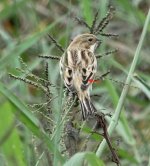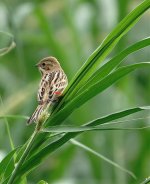MKinHK
Mike Kilburn

I photographed these two birds almost a month apart in November 2018 on my San Tin Fishponds patch in Hong Kong.
Pallas's Reed Bunting is a description species in Hong Kong, so when I looked closely and noted the difference in tertials between the two birds I thought I'd ask for any thoughts from those more familiar with moult in buntings and with Pallas's Reed Bunting in particular.
DSC02217 was taken on 4th Nov
DSC02740 was taken on 30th Nov
Thanks in advance of any thoughts.
Cheers
Mike
Pallas's Reed Bunting is a description species in Hong Kong, so when I looked closely and noted the difference in tertials between the two birds I thought I'd ask for any thoughts from those more familiar with moult in buntings and with Pallas's Reed Bunting in particular.
DSC02217 was taken on 4th Nov
DSC02740 was taken on 30th Nov
Thanks in advance of any thoughts.
Cheers
Mike





